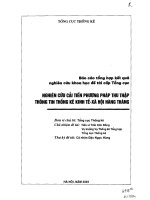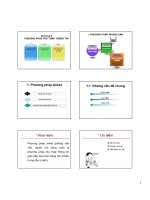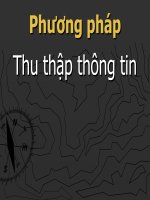Tài liệu Phương pháp thu thập thông tin phân tích công việc (Tài liệu tiếng anh) doc
Bạn đang xem bản rút gọn của tài liệu. Xem và tải ngay bản đầy đủ của tài liệu tại đây (33 KB, 6 trang )
Methods of collecting job analysis information
1. Direct observation
Direct Observation is a method of job analysis to observe and record behavior /
events / activities / tasks / duties while something is happening.
2.
Work methods analysis
Work methods analysis is used to describe manual and repetitive production jobs,
such as factory or assembly-line jobs. Work methods analysis includes time and motion
study and micro-motion analysis.
3.
Critical incident technique (CIT model).
Critical incident technique is a method of job analysis used to identify work
behaviors that classify in good and poor performance.
4.
INTERVIEW METHOD
Interview method is a useful tool of job analysis to ask questions to both
incumbents and supervisors in either an individual or a group setting. Interview includes
structured Interviews, unstructured interview, open-ended questions.
QUESTIONNAIRE METHODS
Questionnaire methods includes 6 techniques as follows:
5.
Position Analysis Questionnaire (PAQ model)
PAQ model is a questionnaire technique of job analysis. It developed by
McCormick, Jeanneret, and Mecham (1972), is a structured instrument of job analysis to
measure job characteristics and relate them to human characteristics. It consists of 195
job elements that describe generic human work behaviors.
6.
Functional job analysis (FJA model)
FJA model is a technique of job analysis that was developed by the Employment
and Training Administration of the United States Department of Labor. It includes 7
scales (numbers) that measure: 3 worker-function scales: measure % of time spent with:
data, people, things; 1 worker-instruction scale; 3 scales that measure reasoning,
mathematics, language.
7.
Work Profiling System (WPS model)
WPS model is a questionnaire technique of job analysis, is a computer-
administered system for job analysis, developed by Saville & Holdsworth, Ltd.
8.
MOSAIC model
MOSAIC model is a questionnaire technique of job analysis used to collect
information from incumbents and supervisors. It contains 151 job tasks rated in terms of
importance for effective job performance and 22 competencies rated in terms of
importance, and needed proficiency at entry.
9.
Common Metric Questionnaire (CMQ model)
CMQ model is a technique of job analysis that was developed by Harvey as a
“worker-oriented” job analysis instrument designed to have applicability to a broad range
of exempt and nonexempt jobs. It includes 41 general questions of background section,
62 questions of contacts with people, 80 items of decision making, 53 items of physical
and mechanical activities, 47 items of work setting.
10.
Fleishman Job Analysis System (FJAS model)
FJAS model is is a technique of job analysis that describe jobs from the point of
view of the necessary capacities. It includes 52 cognitive, physical, psycho-motor, and
sensory ability, each of the categories consists of two parts – an operational and
differential definition and a grading scale.
OTHER METHODS
11.
Task Inventory
A task inventory is a list of the discrete activities that make up a specific job in a
specific organization.
12.
Job element method
This method is same the critical incident technique. It focuses on work behaviors
and the results of this behavior rather than more abstract characteristics. Job element
method developed by Ernest Primoff.
13.
Diary method
This method is a useful tool of job analysis to ask worker maintaining and keeping
daily records or list of activities they are doing on every day…
14.
Checklists and rating scales
Checklist is job analysis method base on an inventory of job elements. You can
ask question about purose of position; key responsibility areas; organization;
relationships; decision making; authority; Skills, knowledge, experience; working
conditions
15.
Competency profiling
Competency modeling is the activity of determining the specific competencies that
are characteristic of high performance and success in a given job. Contents of
competency modeling include skills, knowledge, abilities, values, interests, personalities.
16. Examining Manuals/reference materials
Manuals/reference materials such as quality manual, human resource manual,
procedures, instruction, forms, job description…are useful for analyst in job analysis.
These documents are available for organizations applied to ISO 9000 standard.
17.
Technical conference
Technical conference is a useful tool of job analysis base on Subject Matter
Experts (SMEs). SMEs conduct brainstorming sessions to identify job elements. SMEs
can use all job analysis methods in here.
18.
Threshold Traits Analysis System (TTAS model)
Threshold Traits Analysis System (TTAS model) is a method of job analysis, was
developed in 1970 by Felix Lopez. Threshold traits analysis system include a standard set
of 33 traits: ability traits are “can do” factors and attitudinal traits are “willing to do”
factors.
Combination of methods
In process of job analysis, analyst can use and associate all methods to collecting
job information. For example, when you use direct observation, then you always do
interview method.
Reference documents:
•
What is job analysis
• Job analysis sample
• Purpose of job analysis
• Process of job analysis
• Classification of job analysis methods
• Practical problems with job analysis
• Information source of job analysis









